12 Frozen Shoulder Exercises And Stretches To Try At Home

Performing simple tasks can become very painful and difficult with a frozen shoulder. This condition limits the shoulder's range of motion and causes stiffness, thereby restricting our ability to move freely.
A consistent routine of gentle stretches can gradually restore mobility and reduce pain. Here are 12 frozen shoulder exercises that you can do at home to ease tension and promote better shoulder function:
1. Towel Stretch

The Towel Stretch is one of the most essential stretches for improving flexibility in the shoulder joint and relieving stress from frozen shoulders. It focuses on tense shoulder muscles and ligaments, giving room for wider movement.
This may help increase mobility in the shoulders and reduce pain while doing everyday movements.
How To Do It?
- Hold the top of the towel with one arm above your head, reach behind your back with the other arm, and grab the bottom.
- Pull the towel upward while allowing your lower hand to slide up your back until you feel a stretch.
- Release after holding for 15 to 30 seconds.
- Repeat the same process on the other side.
2. Finger Walk

Next, we have Finger Walk. It is also a perfect exercise of frozen shoulder with a limited range of motion. This workout requires just a wall and minimal shoulder effort to perform. Practicing Finger Walk regularly as part of your shoulder care routine can help you gradually increase flexibility over time.
How To Do It?
- Position your hand against the wall.
- Slowly walk your fingers upward and downward with your elbow slightly bent and your shoulder moving.
- Continue walking your fingers for a few seconds.
- Perform 10 to 12 reps.
3. Cross-Body Stretch

Incorporating the Cross-Body Stretch into your fitness routine is simple because it can be performed anywhere. Always keep your body relaxed, and don't raise your shoulders. Remember to take soft breaths and pull across your body smoothly and gently without rushing.
Stop immediately if you feel any discomfort on your shoulder while performing this frozen shoulder workout.
How To Do It?
- Stand comfortably with a straight back.
- Place one arm shoulder-high across the chest.
- Gently pull your extended arm toward the chest with the other hand.
- You should feel a light stretch in your shoulder after holding this for 20 to 30 seconds.
- Now, release slowly and perform on the other side.
4. Pendulum Stretch
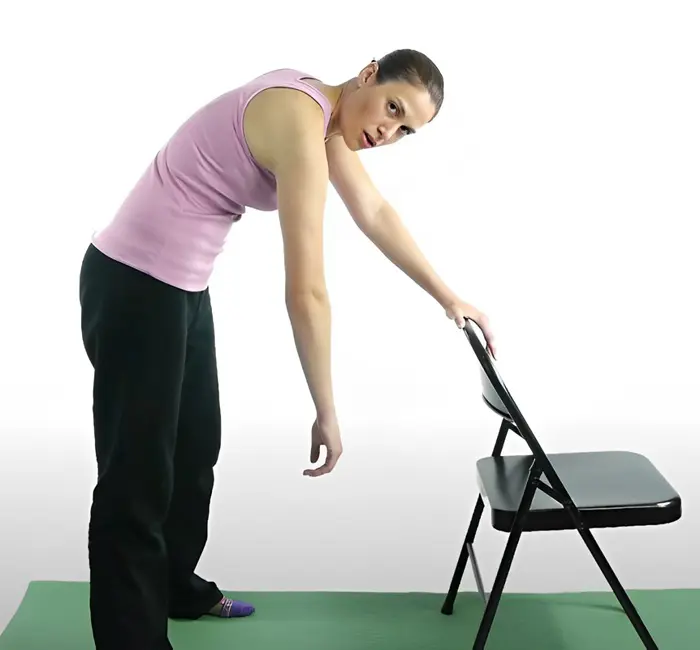
The Pendulum Stretch is another gentle shoulder stretch that can be easily performed at home. Make small circles and gradually increase the size by allowing gravity to control the movement of your arm.
Take deep breaths to enhance relaxation and allow the stretch to release shoulder tension naturally.
How To Do It?
- Stand beside a sturdy table or chair to support yourself.
- Hang your frozen arm straight down from your shoulder and lean forward slightly.
- Your elbow must be slightly bent, and your arm should be completely relaxed.
- Gradually make small clockwise circles with your arm. Do this for 15 to 30 seconds.
- Then, do counterclockwise circles for 15–30 seconds more.
- Make the circles a little bigger as you feel comfortable.
- Practice this activity for desired number of reps.
5. Resistance Band External Rotation

Exercises like External Rotation can prevent injuries by strengthening the rotator cuff muscles and improving general shoulder functioning. It can also increase the range of motion and make daily activities more comfortable.
How To Do It?
- Secure a resistance band at elbow height.
- Sit on a chair with your side to the anchor point.
- Keep your arms close to your body as you grip the band.
- Extend the band in a controlled manner.
- Briefly hold for a few seconds and return to the starting position.
- Switch to the other side and execute this process 10 to 15 times.
6. Shoulder Rolls
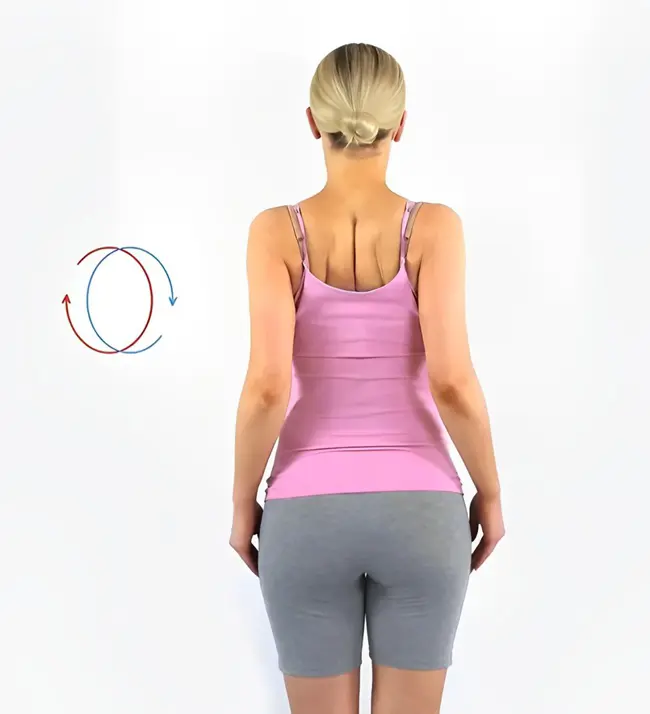
Shoulder Rolls are simple but powerful stretching exercises that reduce stress and improve shoulder strength. This dynamic movement is great to incorporate into daily activities because it aids in boosting blood circulation and releasing tight muscles.
Regular shoulder rolls can also help promote better posture and reduce discomfort from extended sitting.
How To Do It?
- Stand or sit up straight with the feet shoulder-width apart and arms at the sides.
- Inhale deeply and allow the shoulders to rise towards the ears.
- Exhale as you roll your shoulders back and down in a circular motion.
- Lower the shoulders back to the starting position to complete the roll.
- Roll backward and forward 20 to 25 times each.
7. Table Slide Stretch
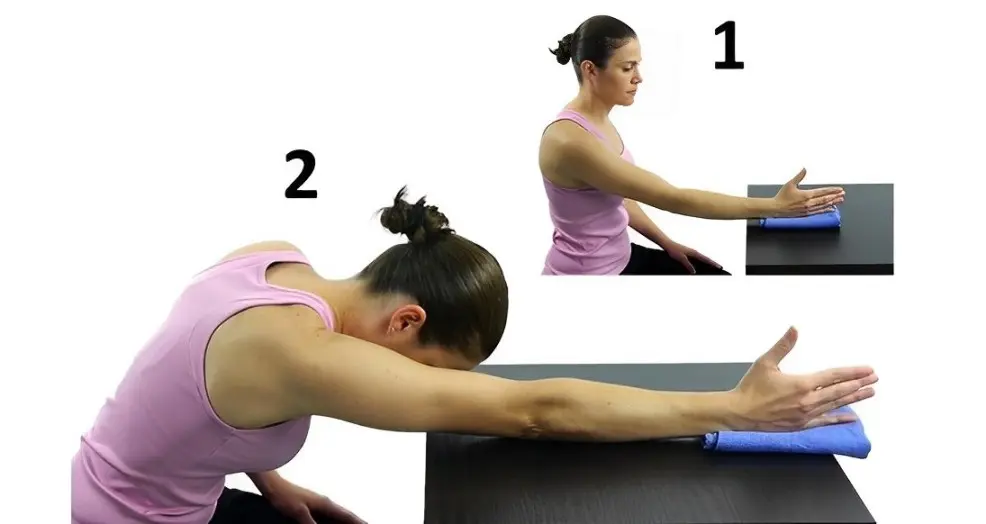
This stretch promotes relaxation by targeting the back and shoulder muscles. It is an easy technique that can be performed at home or in the office.
Uncontrolled swings should be avoided while doing this workout because they can easily result in unnecessary muscle strains.
How To Do It?
- Place the affected arm on the table and put a towel underneath.
- Allow the shoulder to relax, and slowly slide your hand forward down the table.
- Stretch the shoulder and upper back to a relaxing position.
- Take a deep breath and maintain for 15 to 30 seconds.
- Slowly slide the hand back to the beginning position.
- Repeat 10 to 12 times and change sides as needed.
8. Doorway Stretch

While doing the Doorway Stretch, you can raise or lower your elbows in the doorway to change the height of your arms. Other variations include using a towel or strap to increase the resistance or stepping forward with one foot to deepen the stretch.
You can also isolate specific tight areas by performing the stretch with one arm at a time.
How To Do It?
- Stand in a doorway by raising the arms.
- Your palms should face forward with your forearms pressing against the door-frame.
- Take a small step forward with one foot to lengthen the stretch.
- Feel the stretch at the shoulders and chest by leaning gently into the doorway.
- Breathe deeply while holding this position for 20 to 30 seconds.
- Take a slow step backward and return to the initial position.
- Perform this for 5 to 7 reps.
9. Seated Arm Circles
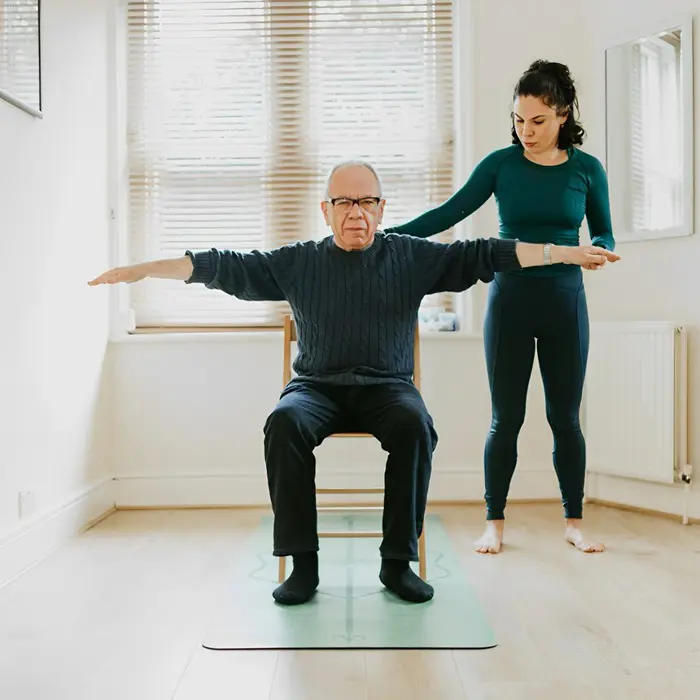
Ideal for stretching the supraspinatus muscles of the shoulder, this workout can be easily performed at home. It will also work on the shoulder joints and their supporting muscles to enhance flexibility.
Be mindful of your posture as you perform this exercise for maximum stretch. If you experience discomfort while doing this move, consulting a fitness professional might prove beneficial.
How To Do It?
- Sit comfortably in a chair and maintain a straight back.
- Extend both arms to your sides at shoulder height by keeping arms parallel to the floor.
- Begin making a small circle with the arms.
- Do it for 15 to 30 seconds and reverse the direction of the shoulder.
- Keep the movement smooth and controlled at all times during this exercise.
10. Cobra Pose

It is a gentle yet effective shoulder mobility exercise that opens up the chest and works the spine. It is simple to perform at home, and we don't need costly equipment to finish the repetitions and sets.
Additionally, we must be careful not to push too hard at the beginning, as this could cause extreme lower back and shoulder pain.
How To Do It?
- Lie face down on the yoga mat by extending the legs.
- Place the hands on the mat with the elbows tucked in against the body.
- Press the pelvis into the mat to engage the core muscles.
- Inhale and lift the chest slowly off the floor by activating the back muscles.
- Engage the shoulder blades down and away from the ears.
- Hold for 25 to 30 seconds by looking upwards.
- Lower your chest to the mat as you exhale.
11. Eagle Arms Stretch

These exercises for frozen shoulders engage several groups of muscles (shoulder, upper back, and arms). Apart from the muscle stretches, the crossing of the arms encourages balance and concentration of the shoulders.
How To Do It?
- Begin by sitting with a straight back.
- Both arms should be straight out in front of the shoulder.
- Bend the elbows with the right arm under your left at your sides.
- Try to touch the palms as you wrap your arms around each other.
- Press the back of the hands if you can't touch your palms together.
- Lift the elbows for a deeper stretch with the shoulders still down.
- Hold the pose for 15-30 seconds with controlled movements.
12. Overhead Resistance Band
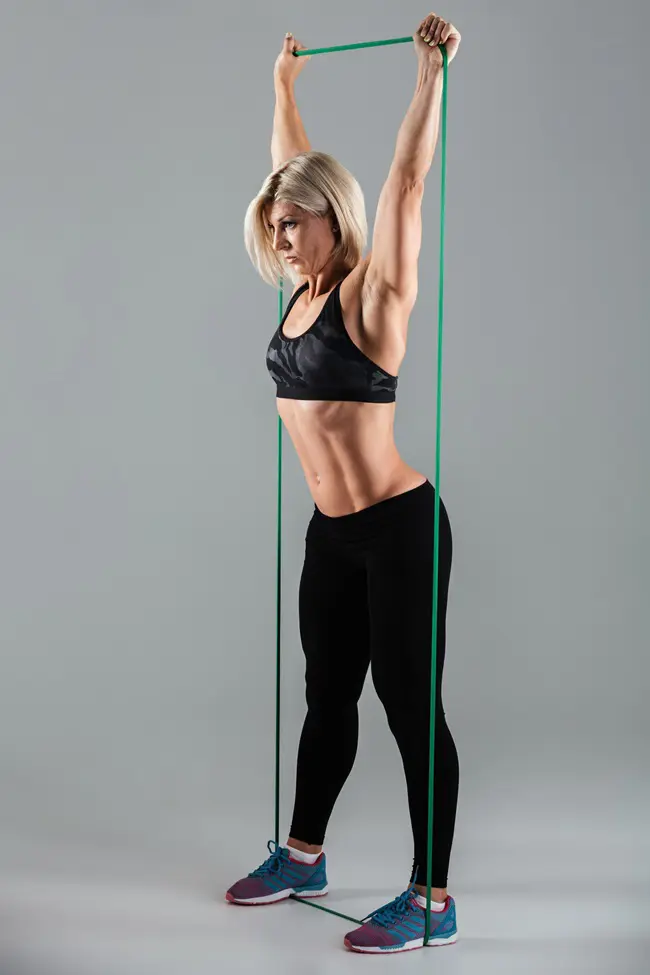
The Overhead Resistance Band stretch is an excellent way to strengthen the shoulders and resilience of the upper body. This workout is fantastic for athletes looking to enhance performance, as it mimics movements encountered in sports like swimming and throwing.
The band shouldn't be too heavy because this can lead to a bad form. Also, keep your core active during the exercise and make controlled movements to avoid injury and enhance effectiveness.
How To Do It?
- Loop a resistance band in the foot and stretch it overhead.
- Raise the arms to shoulder height with your elbows slightly bent.
- Inhale and move the band overhead by completely extending the arms.
- Exhale and bring the band slowly down toward the shoulders while remaining calm.
- Repeat 10 to 15 times with smooth motions at every repetition.
When To Consult A Doctor?
You must see a doctor if you experience shoulder pain, stiffness, or restricted range of motion while performing shoulder exercises for frozen shoulder. Pain that makes it difficult to exercise for more than a few days could indicate some underlying problem.
Additionally, getting medical help as soon as possible can help avoid other issues if you notice a progressive decline in movement or an increase in discomfort.
Individuals with long-term medical illnesses (diabetes or thyroid) should be watchful because they are more likely to feel discomfort during workouts. Consulting with a doctor can also help distinguish a frozen shoulder from other conditions. Early involvement with a healthcare expert can result in a more effective treatment plan.
What Causes Frozen Shoulder?
1. Injury Or Surgery
Recent surgery or injury might increase the risk of developing a frozen shoulder. The immobilization of the connecting tissue surrounding the shoulder also becomes thick and stiff during periods of post-surgical recovery.
A frozen shoulder causes a loss of range of motion that can hinder the body's natural healing process over time.
2. Shoulder Joint Inflammation
Frozen shoulder can also be caused by inflamed shoulder joints. This inflammation could be caused by some disorder (tendonitis or bursitis). It would not only yield pain but also limit the range of motion.
3. Chronic Health Conditions
Diabetes and heart disease are different types of medical conditions known to increase the chance of developing a frozen shoulder. Disorders related to the body's connective tissue often lead to tightening around the joint of the shoulder. This may decrease movement of the upper arm and cause a frozen shoulder.
4. Age and Gender
Adhesive capsulitis mostly happens to individuals within the age bracket of 40 to 60 years and affects more females than males. This may be due to changes in hormones affecting the connective tissue. Hence, proper treatment is essential for effective management.
5. Genetics
A family history can also play a significant role in the development of a frozen shoulder. Genetic traits influencing the shape or function of connective tissue may place individuals at a greater risk.
Safety Tips And Tricks
A mild and regular practice of these workouts encourages mobility and lessens stiffness of the shoulders. Here are some tips and tricks for an effective exercise session:
- Gentle Stretches: Begin with simple stretches like the Cross-Body Stretch or Pendulum Swing. This can preserve a range of motion without overstraining the shoulder.
- Strengthening Workouts: Make sure to include low-resistance band workouts to increase shoulder muscular strength progressively.
- Hold, Don't Bounce: Allow yourself enough time to relax into the stretch. Hold each workout for 15 to 30 seconds with deep breathing.
- Posture Checks: Always keep your posture straight throughout the exercise, especially if you're seated in a chair. This may ease frozen shoulder and pain.
- Avoid Heavy Lifting: Avoid lifting heavy objects or performing harsh shoulder movements to prevent strain.
- Hydrate Your Body: Drinking water reduces the possibility of cramping in the muscles during and after stretching. So, always drink plenty of water to avoid such issues.
- Consistency: Perform these stretches every day by increasing the intensity as your mobility improves for optimal benefits.
How Often Should We Exercise Frozen Shoulder?
It is essential to exercise your frozen shoulders until symptoms improve. Light stretching exercises should be done daily, holding each for 15 to 30 seconds. Perform these exercises two to three times a week to enhance muscular stability in your shoulder.
Also, dedicate 5 to 10 minutes daily to light shoulder mobility exercises such as cross-body and pendulum stretches. Always listen to your body, and consult with your physical therapist for a personalized routine.
Disclaimer: The information provided in this article is for educational purposes only. They should not be considered as a medical advice.
Recent posts
Exercises
Exercises
12 Simple Rotator Cuff Exercises For Conditioned Shoulders
The rotator cuffs are a key muscle group, crucial for a wide range of arm movements and for stabilizing the shoulder joint. When we’re rotating or lifting our arms, the rotator cuffs are working hard. Weakness in these muscles can lead to...
Exercises
12 Amazing Full Body Dumbbell Workout And Exercises
If you're new to fitness, putting together a full-body workout can feel overwhelming. A solid training program targets strength, endurance, flexibility, and balance while working all the major muscle groups. Luckily, dumbbells are versatile tools tha...
Exercises
11 Effective Jawline Exercises To Try For A Chiseled Face
Jawline exercises can lead to changes in the shape of the face, resulting in fuller cheeks and a more youthful appearance. Exercising the neck, chin, jaw, and other facial muscles leads to sharper cheekbones and a prominent jawline. Improving your ja...
Exercises
15 Best Exercises For Waist To Get A Slimmer Midsection
Smaller waist is a common goal for many women, but it requires a mix of exercise, persistence, and a healthy lifestyle. Waist-slimming workouts will tone and shape your midsection while also improving your overall posture and stability. From easy twi...
Exercises
16 Body Weight Leg Exercises To Strengthen Your Lower Body
Bodyweight training is very accessible, popular, and requires little or no equipment at all. With bodyweight exercises, you can target your lower body muscles in different ways to help build stronger legs. Before jumping into weighted movements, thes...
Exercises
12 Achilles Tendon Stretches To Tone Heel And Calf Muscles
The Achilles tendon runs down the back of the lower leg, connecting the heel bone to the calf muscle. It helps lift the heel off the ground while walking. If you suffer from Achilles tendonitis, gently working out the inflamed tendons can aid in quic...







